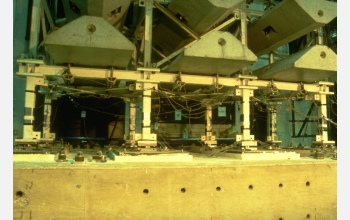Multimedia Gallery
Friction Pendulum System test
The Friction Pendulum System (FPS), which enables buildings to ride out an earthquake by gently swaying back and forth, is installed in this six-story model before being placed on a shake table for testing at the National Center of Earthquake Engineering Research (NCEER), headquartered at the State University of New York at Buffalo.
More About this Image:
The National Science Foundation (NSF) began supporting NCEER in the 1990s through it's Earthquake Hazard Mitigation Program. A major research focus of the center was structural retrofit. Engineers and researchers at NCEER developed the Friction Pendulum System (FPS), a method that would allow a 60,000-ton building to ride out a quake by gently swaying back and forth like a pendulum. The new FPS was put into use for the first time in San Francisco's historic U.S. Court of Appeals. Completed in about 1905, the structure is listed on the National Register of Historic Places and contains ornamental statuary inside and out and architectural elegance from the period. The question of how to make the building safe during future earthquakes arose after it was damaged in the Loma Prieta earthquake in 1989.
Having gone through five years of prior testing, the architects and engineers who proposed the use of the FPS were very confident that it would do well in protecting certain structures when there is extremely strong seismic excitation. Based on their confidence in the system, the owner of the courthouse, the U.S. General Services Administration, chose to use it over other possible earthquake prediction devices.
NSF continues to support earthquake engineering research through programs like the Network for Earthquake Engineering Simulation (NEES) project, funded under the NSF Major Research Equipment Program.
Credit: Courtesy National Center for Earthquake Engineering Research
Images and other media in the National Science Foundation Multimedia Gallery are available for use in print and electronic material by NSF employees, members of the media, university staff, teachers and the general public. All media in the gallery are intended for personal, educational and nonprofit/non-commercial use only.
Images credited to the National Science Foundation, a federal agency, are in the public domain. The images were created by employees of the United States Government as part of their official duties or prepared by contractors as "works for hire" for NSF. You may freely use NSF-credited images and, at your discretion, credit NSF with a "Courtesy: National Science Foundation" notation.
Additional information about general usage can be found in Conditions.
Also Available:
Download the high-resolution JPG version of the image. (871 KB)
Use your mouse to right-click (Mac users may need to Ctrl-click) the link above and choose the option that will save the file or target to your computer.



